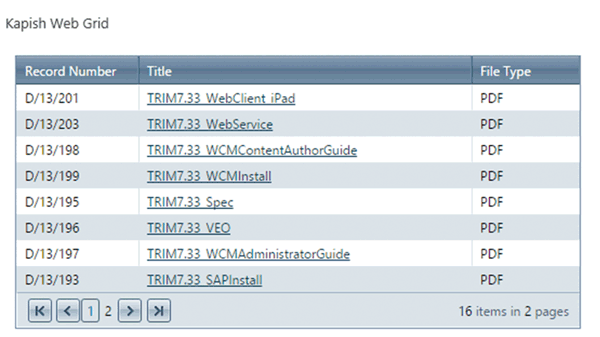A brighter future for HPRM-SharePoint integration

In this article, Kapish Consultant Jon Grundy explores HP’s latest solution to regaining control of the growing records governance and compliance issues associated with snowballing SharePoint content in the enterprise. Jon Grundy is a highly experienced TRIM consultant with a diverse range of industry experience including nine years of HP TRIM/HP RM administration and support. Jon worked with both TOWER Software and HP before joining Kapish in December 2013.
SharePoint is ubiquitous and requires no introduction. Its breadth of functionality makes SharePoint a unique solution that is embedded in many organisations and is now a multi-billion dollar product for Microsoft.
According to Forrester's Q3 2014 Global SharePoint Usage Online Survey, Microsoft's drive to move SharePoint users to the cloud is working, but the complexity of existing on-premises implementations is gating a widespread cloud adoption for the time being. However, despite SharePoint’s popularity, many implementations face a multitude of challenges: a growing governance and compliance headache; publishing content from other line-of-business applications; and, record capture workflow (or lack thereof). Integrating HP Records Manager and SharePoint solves these issues by providing a path to full compliance, simple document exposure and rule-based record capture.
Traditionally SharePoint and HP Records Manager are administered by separate teams in an organisation. Integration bridges this gap and unites these applications so that organisations can realise cost savings in enterprise storage, reduce SharePoint administration overheads, empower users to work more efficiently and independently, and provide peace of mind for records managers.
To understand the potential for integration inside your organisation, you first need to understand the problem it solves. SharePoint provides some clear advantages when it comes to project collaboration, document management and allowing users to work in accordance with how they want to work. Unfortunately this same set of features can also lead to chaotic content management, leaving organisations vulnerable to audits, FOI and Privacy Act requests among other issues.
Applying retention policies to content in SharePoint remains a massive headache for records managers. A NSW State Records assessment of SharePoint 2010 concluded that “There is no single way to design and configure SharePoint so that it facilitates good record-keeping.”
Entire sites, lists and libraries can live on indefinitely, becoming lost and forgotten in run-away SharePoint environments. Despite the issue being well-known, attempts to pull existing and future data from SharePoint into HPRM often fail.
These issues were identified early in SharePoint’s emergence by a forward-thinking team of developers from Unique World Software who first developed a 3rd party integration between SharePoint and TRIM Context called the TIPS SharePoint Connector in 2003. However TRIM/HPRM - SharePoint integration has proven difficult to implement, leaving many organisations hoping that the next version would resolve the problems. The team of TIPS developers now working inside HP showed a dogged persistence to re-build and improve. It was this “stand back up, brush yourself off and see what we can do better” attitude that has finally lead to the successful integration of today (see timeline below).

The new Rules Based Management Screen in HP RM 8.2
The latest release of the HPRM SP Integration solves many of the challenges faced with previous iterations, introducing an impressive feature set for organisations looking to upgrade to SharePoint 2013/Online and HP Records Manager 8.2.
One of the biggest challenges in previous versions of the integration was the limited record management options and workflows (Lifetime Management Policies) that defined when and how an object in SharePoint would be captured into TRIM.
With HPRM 8.2, a new Rules-based management feature allows the use of IF/THEN conditions to define extremely granular rules and triggers on when content will be captured and how it is captured. This provides organisations with a hugely flexible toolset to ensure accurate governance and compliance of corporate records in SharePoint.
Technical difficulty in deploying the integration was a common experience, often requiring changes to the SharePoint server architecture or authentication configuration. The new App model displays a much smarter approach by Microsoft to delivering 3rd party solutions and HP has made quick use of this with the new HPRM SP Integration.
Kapish Web Grid
A primary function of a SharePoint intranet portal is the publication of policies, procedures, forms, templates and media within the business. In previous versions of the integration, this would be achieved using ‘Record Exposure’ into a pre-determined SharePoint library.
The results of the record exposure though were often inconsistent and troublesome, leading to large, flat lists of documents in a single library. Although sub-folder exposure provided some structure in HP TRIM 7.3, this functionality is not available in SharePoint 2013 and HPRM due to architecture changes.
To fill this gap, Kapish Web Grid is a solution to displaying and managing lists of documents from a HP TRIM or HP Records Manager dataset. It is also version independent, meaning that organisations that currently have incompatible SharePoint and TRIM/HPRM versions can still enable a publishing solution for their SharePoint intranet.
Kapish Web Grid allows the results of Saved Searches in HPRM to be published to any Web page, including SharePoint pages. Dynamic Saved Searches allow sets of documents, including drill-down containers to be exposed on SharePoint pages.

Kapish Web Grid in SharePoint showing Container Drill downs
In previous versions of the SharePoint integration, links to individual TRIM documents could be manually created and inserted into sites and pages, however with the change in the integration model, these links will now be unusable. To provide a consistent experience and greater continuity throughout versions, Kapish Easy Link can deliver an organisation-wide URL linking system to all HP TRIM and HP Records Manager records and the ability to generate SharePoint compatible links for use on the intranet.
If your business is looking to streamline and simplify the record keeping and user experience within SharePoint, HPRM SP Integration has evolved to provide a capable and solid platform.
“Kapish are fortunate to have long standing experience and expertise with the integration from the days of TIPS, right through to the latest HPRM SP Integration App,” said Jon-Paul Williams, Director Kapish Services Pty Ltd.
“Lessons learned over the last decade provide a solid foundation for all SharePoint Integration projects, backed by a thorough technical understanding of the integration history and how the integration has evolved to its current form.”
To see more on what the integration can deliver and an in-depth presentation, including Web Grid and Easy Link functionality, Kapish is hosting a free webinar on Thursday 19 November at 10:00 am (AEST) to showcase the latest release of the HPRM-SPI module. To register Click HERE
TRIM-SharePoint Integration History
2003-2004 - Unique World Software developed 3rd party integration - TIPS SharePoint Connector.
2007 - TOWER Software acquires TIPS and asks Jaimie Tilbrook to work for them. TIPS provided as an optional module in TRIM Context 6 - TRIM Context SharePoint Integration (TCSI)
2008-2010 - Hewlett-Packard acquires TOWER Software. HP TRIM 7 launched and TCSI redeveloped as HP TRIM SharePoint Integration. Product supports MOSS2007 and SharePoint 2010. Many technical challenges implementing the integration
2010-2014 - Product more widely adopted with HP TRIM 7.3 and SharePoint 2010. Microsoft develops new ‘App’ integration model for SharePoint 2013. HP Records Manager 8 released with complete rebuild in 8.1
2015 - HPRM 8.2 Released and SharePoint 2013 integration is the most capable release to date.
